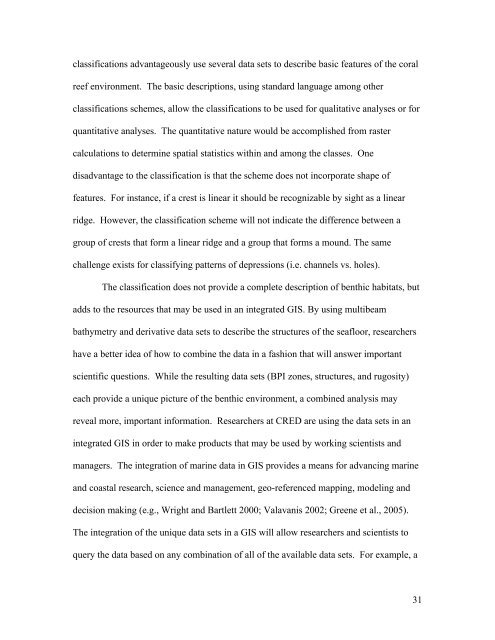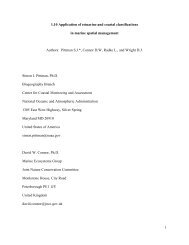A Benthic Terrain Classification Scheme for American Samoa
A Benthic Terrain Classification Scheme for American Samoa
A Benthic Terrain Classification Scheme for American Samoa
You also want an ePaper? Increase the reach of your titles
YUMPU automatically turns print PDFs into web optimized ePapers that Google loves.
classifications advantageously use several data sets to describe basic features of the coral<br />
reef environment. The basic descriptions, using standard language among other<br />
classifications schemes, allow the classifications to be used <strong>for</strong> qualitative analyses or <strong>for</strong><br />
quantitative analyses. The quantitative nature would be accomplished from raster<br />
calculations to determine spatial statistics within and among the classes. One<br />
disadvantage to the classification is that the scheme does not incorporate shape of<br />
features. For instance, if a crest is linear it should be recognizable by sight as a linear<br />
ridge. However, the classification scheme will not indicate the difference between a<br />
group of crests that <strong>for</strong>m a linear ridge and a group that <strong>for</strong>ms a mound. The same<br />
challenge exists <strong>for</strong> classifying patterns of depressions (i.e. channels vs. holes).<br />
The classification does not provide a complete description of benthic habitats, but<br />
adds to the resources that may be used in an integrated GIS. By using multibeam<br />
bathymetry and derivative data sets to describe the structures of the seafloor, researchers<br />
have a better idea of how to combine the data in a fashion that will answer important<br />
scientific questions. While the resulting data sets (BPI zones, structures, and rugosity)<br />
each provide a unique picture of the benthic environment, a combined analysis may<br />
reveal more, important in<strong>for</strong>mation. Researchers at CRED are using the data sets in an<br />
integrated GIS in order to make products that may be used by working scientists and<br />
managers. The integration of marine data in GIS provides a means <strong>for</strong> advancing marine<br />
and coastal research, science and management, geo-referenced mapping, modeling and<br />
decision making (e.g., Wright and Bartlett 2000; Valavanis 2002; Greene et al., 2005).<br />
The integration of the unique data sets in a GIS will allow researchers and scientists to<br />
query the data based on any combination of all of the available data sets. For example, a<br />
31
















